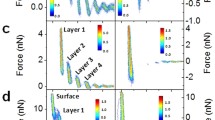Abstract
We describe how a novel magnetic force controlled atomic force microscope and point contact probe has enabled quantitative measurements to be made of the water present between the tip and the sample when the microscope is operated in air. To further understand the role of water in atomic force microscopy a low water content system consisting of a hydrophobic tip and sample was investigated. Although highly reproducible, the results indicate that liquid is still present in the tip-surface gap. The consequent limitations of all atomic force microscopes, when operating in air, are discussed.
Access this chapter
Tax calculation will be finalised at checkout
Purchases are for personal use only
Preview
Unable to display preview. Download preview PDF.
Similar content being viewed by others
References
G. S. Blackman, C. M. Mate and M. R. Philpott and G. A. Somorjai, “Studies of molecular wear with an atomic force microscope”, Proceedings of the STM′90/NANO I Conference, Baltimore, U.S.A., July 1990.
H. Heinzelmann, E. Meyer, L. Scandella, P. Grütter, Th. Jung, H. Hug, H.-R. Hidber and H.-J. Güntherodt “Topography and correlation to wear of hydrogenated amorphous carbon coatings: an atomic force microscopy study”, Wear, Eds. F. F. Ling and C. H. T. Pan, (Springer-Verlag, New York, 1988).
T. A. Jung, A. Moser, H. J. Hug, D. Brodbeck, R. Hofer, H. R. Hidber and U. D. Schwarz “The atomic force microscope used as a powerful tool for machining surfaces”, Ultramicroscopy 42, 1446 (1992)
N. A. Burnham, D. D. Dominguez, R. L. Mowery and R. J. Colton “Probing the surface forces of monolayer films with an atomic-force microscope”, Phys. Rev. Lett. 64, 1931 (1990).
N. A. Burnham, R. J. Colton and H. M. Pollock “Work-function anisotropies as an origin of long-range surface forces”, Phys. Rev. Lett. 69,144 (1992)
J. B. Pethica and W. C. Oliver “Tip surface interactions in STM and AFM”, Physica Scripta T19, 61 (1987).
D. Rugar and P. Hansma “Atomic force microscopy”, Physics Today 10, 23 (1990).
S. P. Jarvis, A. Oral, T. P. Weihs and J. B. Pethica, “A Novel Force Microscope and Point Contact Probe”, Rev. Sci. Inst. 64, 3515 (1993).
D. Tabor and R. H. S. Winterton “The direct measurement of normal and retarded van der Waals forces”, Proc. Roy. Soc. Lond. A. 312, 435 (1969).
J. S. McFarlane and D. Tabor “Adhesion of solids and the effect of surface films”, Proc. Roy. Soc. Lond. A. 202, 224 (1950).
C. M. Mate, M. R. Lorenz and V. J. Novotny “Atomic force microscopy of polymeric liquid films”, J. Chem. Phys. 90, 7550 (1989).
S. P. Jarvis, T. P. Weihs, A. Oral and J. B. Pethica, “Mechanics of Contacts at less than 100Å scale: indentation and AFM”, Thin Films — Stresses and mechanical Properties IV, Mater. Res. Soc. Proc. 308, 127 (1993).
J. B. Pethica and D. Tabor “Contact of characterised metal surfaces at very low loads: deformation and adhesion”, Surface Science 89, 182 (1979).
M. D. Pashley and D. Tabor “Adhesion and deformation properties of clean and characterised metal micro-contacts”, Vacuum 31, 619 (1981).
Author information
Authors and Affiliations
Editor information
Editors and Affiliations
Rights and permissions
Copyright information
© 1995 Springer Science+Business Media Dordrecht
About this chapter
Cite this chapter
Jarvis, S.P., Pethica, J.B. (1995). Hydrophobic Surface Interactions Studied Using a Novel Force Microscope. In: Güntherodt, H.J., Anselmetti, D., Meyer, E. (eds) Forces in Scanning Probe Methods. NATO ASI Series, vol 286. Springer, Dordrecht. https://doi.org/10.1007/978-94-011-0049-6_10
Download citation
DOI: https://doi.org/10.1007/978-94-011-0049-6_10
Publisher Name: Springer, Dordrecht
Print ISBN: 978-94-010-4027-3
Online ISBN: 978-94-011-0049-6
eBook Packages: Springer Book Archive




